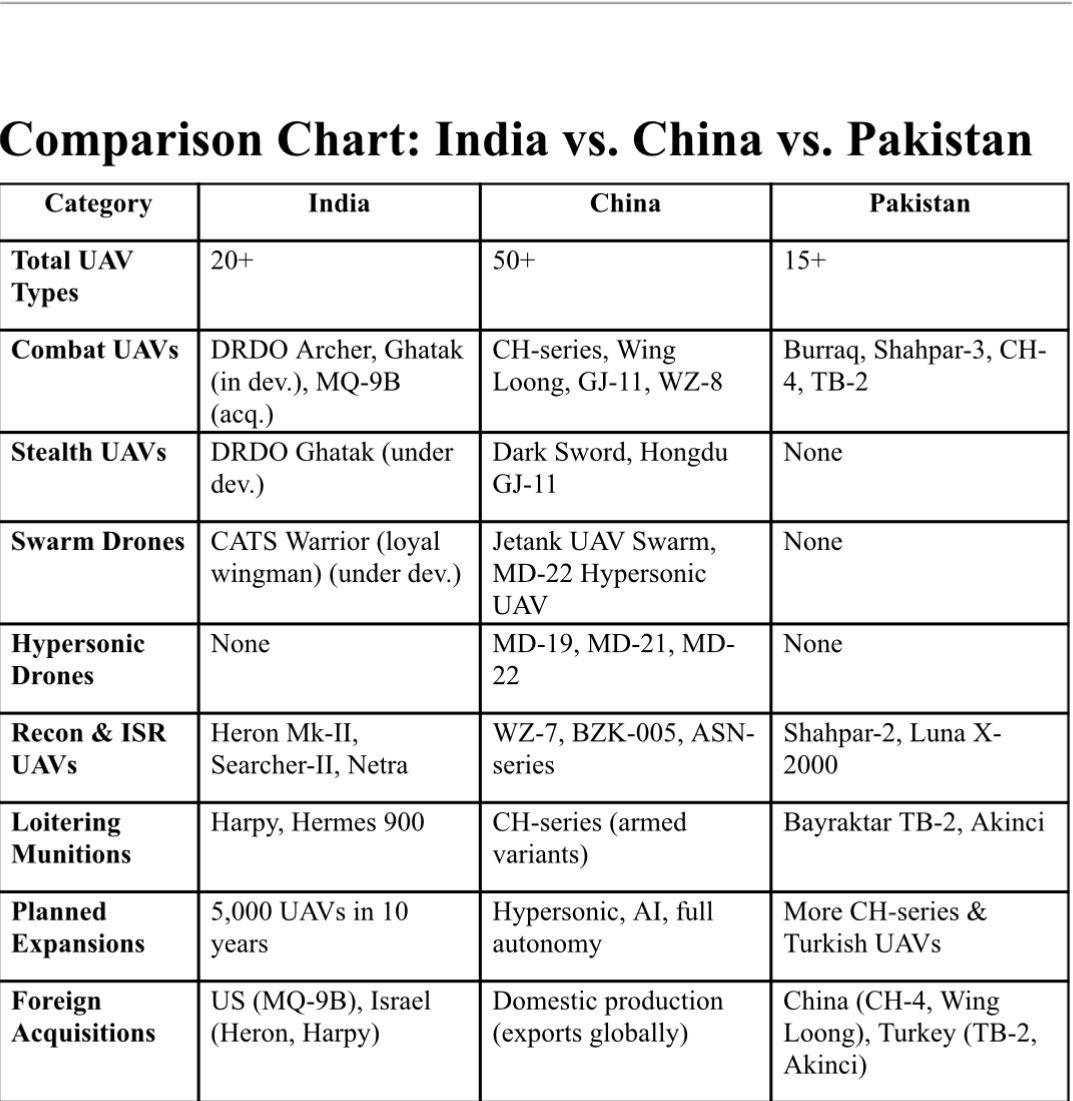synopsis
UAVs have revolutionised modern warfare, reshaping the dynamics of military operations. These drones provide unparalleled tactical advantages and improve operational efficiency across a range of combat scenarios.
New Delhi: With the evolving nature of warfare, leading militaries worldwide are significantly enhancing their unmanned aerial vehicle (UAV) capabilities to secure battlefield dominance.
UAVs have revolutionised modern warfare, reshaping the dynamics of military operations. These drones provide unparalleled tactical advantages and improve operational efficiency across a range of combat scenarios.
For India, the two-front military threat from China and Pakistan remains a formidable challenge with no easy answers.
Although India is rapidly upgrading its UAV capabilities, its adversaries are also steadily advancing, equipping their forces with drones that boast greater lethality and capabilities.
Here’s a closer look at the UAV fleets maintained by these three neighbouring nations:
China
The People's Liberation Army (PLA) operates a diverse and advanced fleet of UAVs, including the CH-4, CH-5, Wing Loong-2, and the stealth-capable CH-7 UCAV. These drones are integral to China's efforts to enhance its reconnaissance and combat capabilities.
-
CH-4
The CH-4 is a reconnaissance drone with an endurance of 30–40 hours and a range of 3,500–5,000 km. Its variant, the CH-4B, is a versatile platform capable of both combat and reconnaissance missions, with a payload capacity of 250–345 kg. It can deploy air-to-ground missiles from an altitude of 5,000 metres. -
CH-5
Often compared to the United States’ Reaper drone, the CH-5 is a highly capable UAV that strengthens China's combat and surveillance operations. -
Wing Loong-2
Also known as the Chengdu GJ-2, the Wing Loong-2 is a medium-altitude, long-endurance (MALE) UAV. It is equipped with a range of weapons and is primarily used by the People's Liberation Army Air Force (PLAAF) for surveillance and aerial reconnaissance missions. -
CH-7
The CH-7 is a stealthy, long-endurance unmanned combat air vehicle (UCAV) akin to the US Navy's X-47B. Designed for strategic operations, it excels in tracking enemy ships and providing targeting data for ground-based missile systems.
China’s Drone Categories & Key Models:
Strategic Recon Drones:
○ WZ-7 Soaring Dragon (High-altitude surveillance)
○ BZK-005 (Maritime surveillance)
Tactical ISR Drones:
○ ASN series (ASN-205, ASN-206, ASN-207, ASN-209)
Armed UAVs:
○ CH (Rainbow) Series (CH-4, CH-5, CH-9)
○ Wing Loong Series (I, II)
Stealth & Advanced UCAVs:
○ Hongdu GJ-11 (Stealth UCAV)
○ AVIC Dark Sword (Unmanned Fighter Jet)
○ WZ-8 (High-speed Recon Drone)
Swarm & Carrier Drones:
○ Jetank (Carries smaller UAVs for swarm attacks)
○ Multirotor VTOL UAVs for militia & police units
Hypersonic & Future UAVs:
○ MD-19, MD-21 (Hypersonic Recon & Strike)
○ MD-22 (Hypersonic UAV Testbed)
Composition & Expansion Plans:
● Current Fleet Size: Estimated at tens of thousands of UAVs.
● Future Plans: Heavy investment in hypersonic drones, AI-driven swarming tech, and stealth UCAVs.
Pakistan
Pakistan's UAV fleet is estimated to comprise 150–200 drones, including the CH-3-based Burraq, Wing Loong-1 and Wing Loong-2, as well as the Turkish-origin Bayraktar TB2 drones. These UAVs enhance Pakistan's reconnaissance and combat capabilities significantly.
Pakistan’s Drone Categories & Key Models:
Reconnaissance & ISR UAVs:
○ GIDS Shahpar-1 & 2 (MALE ISR)
○ GIDS Uqab-NG (Short-range ISR)
○ SATUMA Jasoos II "Bravo+" (ISR)
Combat & Strike UAVs:
○ NESCOM Burraq (Armed Drone, based on China’s CH-3)
○ GIDS Shahpar-3 (New Armed UAV, 2024)
Chinese Combat Drones:
○ CASC CH-4B (Strike UAV, similar to US MQ-9)
○ CAIG Wing Loong I & II (Combat & Recon UAVs)
Turkish Combat Drones:
○ Bayraktar TB-2 (Combat UAV, used in Azerbaijan & Ukraine)
○ Bayraktar Akinci (Heavy-armed, long-range UAV)
Other Foreign UAVs:
○ AeroVironment RQ-11 (Mini UAV, US)
○ EMT Luna X-2000 (ISR, Germany)
○ Boeing Insitu ScanEagle (Recon, US)
Composition & Expansion Plans:
● Current Fleet Size: Estimated at hundreds of operational UAVs.
● Future Plans: Increasing armed drone acquisitions from China & Turkey, developing Shahpar-III-class UCAVs.
India
India primarily operates Israeli-origin UAVs, such as the Heron and Searcher Mark II, which play a key role in surveillance and intelligence-gathering operations.
India's drone categories and key models
Reconnaissance & Surveillance:
○ DRDO Netra (Micro UAV)
○ DRDO Nishant (Short-range)
○ DRDO Panchi (Wheeled version of Nishant)
○ DRDO Lakshya (Aerial Target)
○ DRDO Ulka (Supersonic Target Drone)
Combat & Strike UAVs:
○ DRDO Archer (Armed version of Rustom)
○ DRDO Ghatak (Stealth UCAV, under development)
○ HAL Combat Air Teaming System (CATS) – Loyal Wingman concept
Medium & High-Altitude Long Endurance (MALE & HALE) Drones:
○ DRDO Rustom-I
○ TAPAS-BH-201 (Rustom-II)
○ DRDO Abhyas (Target Drone)
Israeli Drones:
○ Heron (Mark-I & II) (MALE)
○ Searcher Mk I & II (Short-range ISR)
○ Harpy (Loitering Munition)
American Drones:
○ MQ-9B SeaGuardian (Under acquisition)
○ MQ-9B SkyGuardian (Under acquisition)
European/Other Acquisitions:
○ Black Hornet Nano-Drones (Recon)
○ Hermes 900 (Manufactured by Adani-Elbit)
Composition & Expansion Plans:
● Current Fleet Size: Estimated 2,000–2,500 drones across the Indian Armed Forces.
● Planned Inductions: Approx. 5,000 UAVs in the next decade.

India's Push for Indigenous UAV Development
In a bid to strengthen its UAV ecosystem, India is prioritising indigenous development by encouraging local firms to design and manufacture advanced UAV platforms. This initiative aims to reduce reliance on foreign imports while fostering strategic collaborations with global defense manufacturers, research institutions, and technology start-ups. Additionally, efforts are underway to enhance UAV capabilities with advanced electronic warfare systems and protective measures.
DRDO’s Contributions
-
Rustom-II (TAPAS-BH-201)
Rustom-II is a Medium Altitude Long Endurance (MALE) UAV developed for Intelligence, Surveillance, and Reconnaissance (ISR) missions. Continuous improvements are being made to align it with the evolving operational requirements of the Indian Army. -
Archer-NG
Archer-NG is a weaponised MALE UAV capable of operating at an altitude of 30,000 feet. It can carry a payload of 300 kg and has a range of 1,000 km. Its maiden flight is anticipated soon, marking a significant milestone in India's indigenous UAV development.
Role of iDEX in UAV Development
The Innovations for Defence Excellence (iDEX) initiative has been pivotal in accelerating the growth of India’s UAV sector by providing funding and support to start-ups and defense innovators. Through iDEX, several UAV-focused start-ups are developing advanced solutions, including next-generation swarming drones, high-altitude surveillance UAVs, and loitering munitions for frontline operations. This initiative serves as a critical link between private-sector innovation and the military’s evolving requirements.
The Way Forward: Preparing for the Future
To ensure strategic superiority in UAV capabilities, India’s roadmap should focus on the following priorities:
-
Expedited Procurement: Streamlining acquisition processes to enable the rapid deployment of state-of-the-art UAVs.
-
AI-Integrated Autonomy: Harnessing artificial intelligence (AI) to facilitate autonomous missions and improve decision-making efficiency.
-
Scalability & Adaptability: Designing UAV platforms that can seamlessly adapt to multi-domain operational requirements.
-
Export Potential: Strengthening indigenous UAV production to position India as a leading global supplier of unmanned defense systems.
)
 subscribe to Asianet News Whatsapp channel by clicking here.
subscribe to Asianet News Whatsapp channel by clicking here.